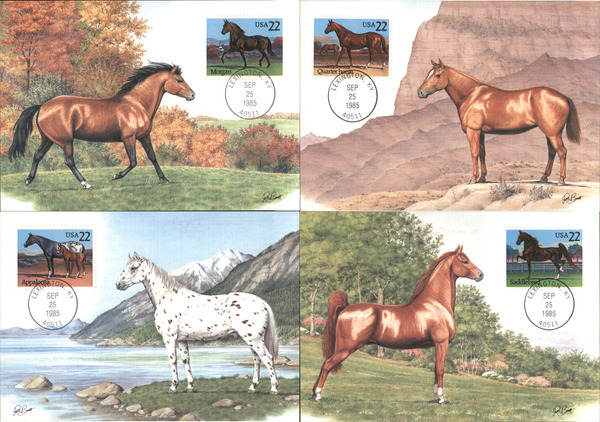Set of 4: 22c Horses
Front:
USA22
EXINGION
SEP
Morgan
KY
25
1985
40511
Quarter boTC
USA22
Quarter herse
EXINGTON
SEP
25
1985
40511
KY
NIXIN
USA22
Appaloose
TON
SEP
25
1985
40511
KY
LEX
Saddlebred
USA 22
Saddlebred GTON
SEP
25
1985
40511
KY
LEX
Back:
THE MORGAN
First Day of Issue: September 25, 1985
First Issue Location: Lexington, Kentucky
Unlike most American horses which have developed
from the crossing of breeds, the Morgan Horse is de-
scended from a single sire of incredible strength and
merit. This horse was orginally named Figure, but is
better known as Justin Morgan — the name of his second
owner. The origins of this amazing horse are obscure.
However, he was truly one of the world's most remark-
able horses. Although he was renowned for his strength
and endurance, Justin Morgan's horse was relatively
small, standing only a little more than 41/2 feet tall and
weighing around eight hundred pounds. Used to pull
the plough to plant crops, clear fields and pull heavy
loads, this one small horse literally worked from sunrise
until dusk. When not working in the fields, Justin Morgan
was matched in demanding weight-pulling contests ...
and was raced under saddle and harness — never to be
beaten! The qualities of this one amazing horse were
carried on in his offspring establishing one of America's
most popular breeds of horses.
No. 85-50
©1985 The Maximum Card Collection
A Division of Unicover Corporation . Cheyenne, WY 82008-0007
Original painting by Peter Barrett.
THE QUARTER HORSE
First Day of Issue: September 25, 1985
First Issue Location: Lexington, Kentucky
The most numerous of all American horses — and pos-
sibly the first breed developed in North America — the
Quarter Horse was first bred in the early 1700s in colonial
America. These muscular animals performed well under
the heavy work of the harness. But their greatest fame
came from their extraordinary ability to make quick starts
and run incredibly fast over short distances. However,
the new breed could only race at great speeds for short
distances and was therefore seldom raced more than 440
yards, or a “quarter" mile – hence the horse's name.
With the development of the Thoroughbred, the Quarter
Horse was temporarily forgotten as a racer, and accom-
panied the pioneers westward where the horse became
an indispensable partner to the cowboy and farmer.
Today, the strong but gentle Quarter Horse is an all-
around pleasure horse and the star of rodeos everywhere.
Indeed, with nearly one million registered Quarter
Horses around the world, this sturdy horse is the world's
most popular horse.
No. 85-49
©1985 The Maximum Card Collection
A Division of Unicover Corporation • Cheyenne, WY 82008-0007
Original painting by Peter Barrett.
THE APPALOOSA
First Day of Issue: September 25, 1985
First Issue Location: Lexington, Kentucky
Although horses originally evolved in North America
and then migrated to other parts of the world, they
became extinct on the American continent during the
Ice Age. The horse did not reappear on American soil
again until Spanish explorers brought horses with them
on their discovery journeys. Some of these horses es-
caped and formed wild herds which were later domesti-
cated by the American Indians. The Nez Perce Indian
tribe domesticated, and actually preserved, what may
be one of the oldest breeds of horses — the colorful and
spotted Appaloosa. This unusual horse was prized by
the Indians for its unique markings as well as its speed
and hardiness. Interestingly, the Nez Perce Appaloosa
was strikingly similar to the markings of an ancient breed
of horse seen in early Chinese and Persian art forms.
Their ancestors probably reached Europe by way of Asia
and were then taken to Mexico by Spanish explorers,
eventually migrating north to the Nez Perce Indians.
No. 85-52
©1985 The Maximum Card Collection
A Division of Unicover Corporation . Cheyenne, WY 82008-0007
Original painting by Peter Barrett.
THE AMERICAN SADDLEBRED
First Day of Issue: September 25, 1985
First Issue Location: Lexington, Kentucky
Generations ago, wealthy Kentucky planters often spent
long days in the saddle overseeing their fields. Because
they spent so much time on horseback, they desired a
horse that had a comfortable and smooth gait . . . yet
was handsome in appearance. To develop such a breed,
the Kentucky planters crossed a famed Thoroughbred
sire with mares of other breeds including the Morgan,
the early Narragansett and the Canadian Pacer. They
eventually developed a beautiful new breed of horse
characterized by proudly arched necks, rounded com-
pact bodies, and a spirited high-stepping trot. But this
new breed's greatest fame came from its incredibly
smooth, comfortable ride — which earned the horse the
name the Kentucky Saddler, or American Saddlebred.
The Saddlebred's smooth gait won it favor throughout
the South as a gentle saddle and harness horse. Today,
the Saddlebred is America's supreme show horse . . . al-
though this gentle-gaited breed is still loved as an all-
around saddle horse.
No. 85-51
©1985 The Maximum Card Collection
A Division of Unicover Corporation . Cheyenne, WY 82008-0007
Original painting by Peter Barrett.










